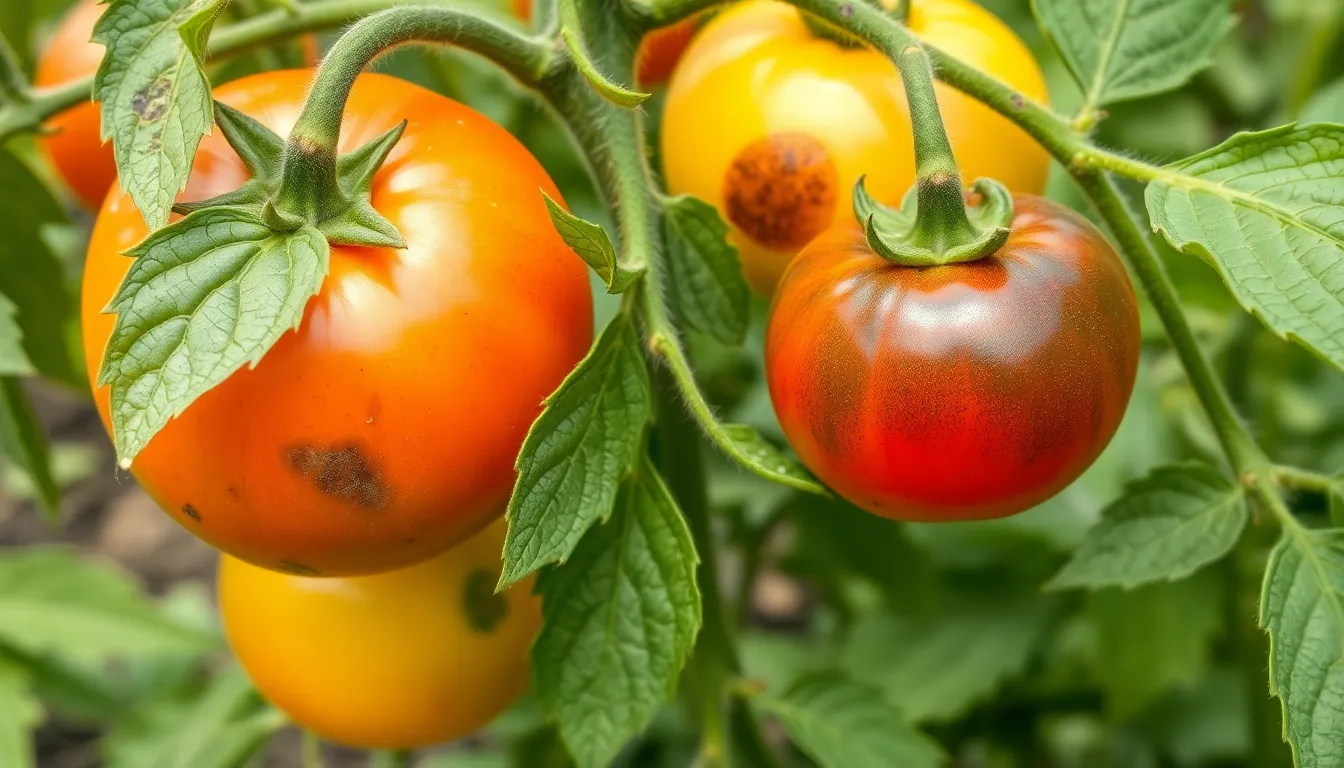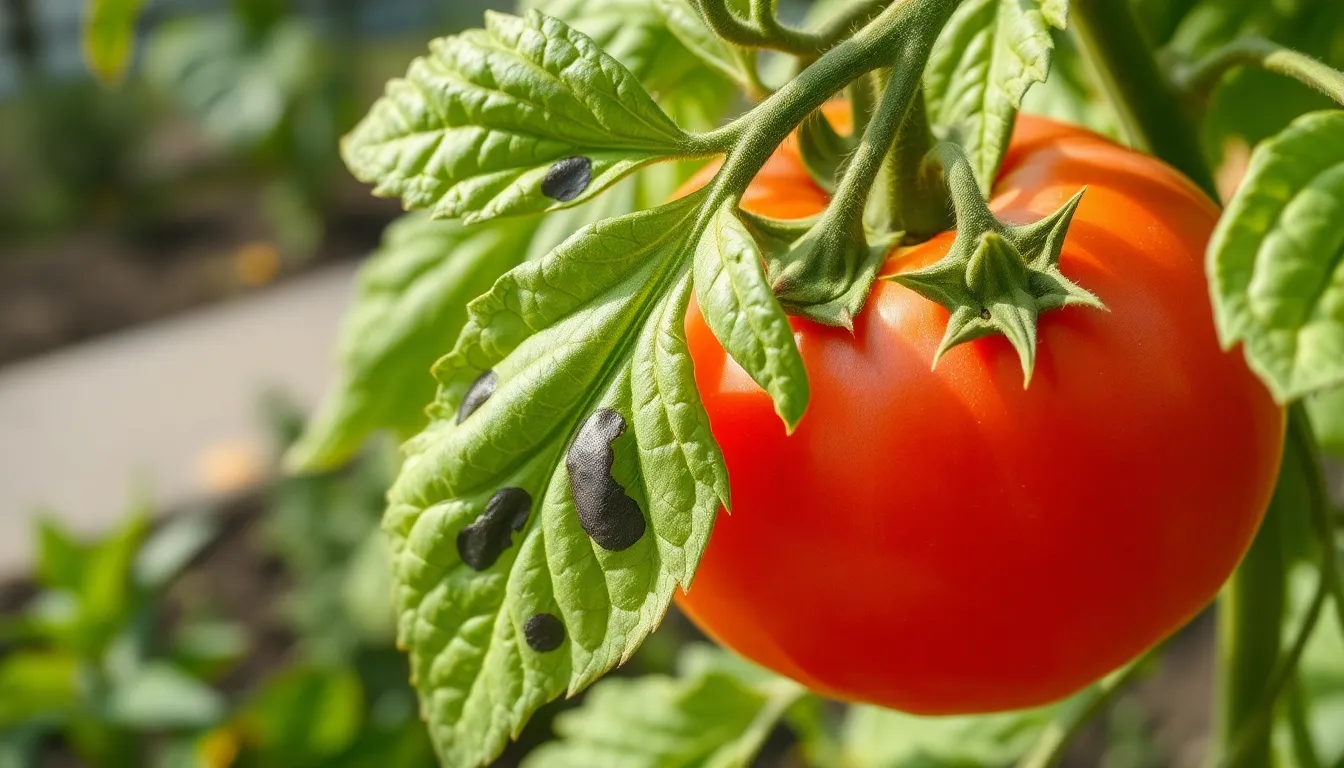Tomatoes are the crown jewels of any garden, but even the mightiest can fall victim to a variety of pesky diseases. Imagine nurturing your plants only to discover they’ve been struck by a mysterious ailment. It’s like a soap opera for your garden, complete with drama, heartbreak, and the occasional wilted leaf.
Picture of Tomato Plant Diseases
Tomato plants can face numerous diseases that impact their growth and yield. Common diseases include blight, wilt, and mosaic virus. Each disease presents specific symptoms and requires distinct management strategies.
Early blight shows up as dark spots on older leaves. This disease usually affects lower leaves first, leading to yellowing and eventually leaf drop. Late blight, responsible for devastating losses, manifests as dark, water-soaked spots on leaves and stems. Unlike early blight, late blight leads to rapid deterioration, often resulting in total crop failure.
Fungal and bacterial wilts pose significant threats. Fusarium wilt affects the vascular system, causing wilting and yellowing of leaves while stunting plant growth. Bacterial wilt, often transmitted by insects, results in droopiness and a sudden collapse of plants, with little warning.
In addition to wilts, viral infections like tomato mosaic virus present considerable challenges. Symptoms include mottled leaves and stunted growth. This virus can spread rapidly, particularly in crowded growing conditions.
Cultivating resistant varieties of tomatoes helps mitigate disease risks. Additionally, ensuring proper sanitation practices in the garden minimizes pathogen presence. Regular monitoring and early detection play crucial roles in managing plant health effectively.
Understanding these diseases equips gardeners to take timely action, safeguarding their tomato harvest. Knowledge of symptoms and control methods fosters a proactive approach to plant care.
Common Tomato Plant Diseases

Tomato plants face several diseases that threaten their growth and yield. Identifying these issues promptly can lead to effective management and healthier plants.
Early Blight
Early blight takes shape as dark brown to black spots on older leaves. Severity increases during warm, moist conditions, leading to premature leaf drop. Healthy plants might develop stunted growth due to nutrient loss. Proper spacing improves air circulation. Applying fungicides helps in controlling this disease when used at the first sign of symptoms. Cultivating resistant varieties minimizes the impact.
Late Blight
Late blight causes significant damage and can destroy crops rapidly. Symptoms include large, dark water-soaked spots on leaves and stems. Cool, wet conditions favor its spread through spores. Early detection is crucial, as this disease poses a risk of rapid plant collapse. Efficient management relies on crop rotation and removing infected plant debris. Chemical treatments also offer protection, especially in areas with a history of late blight.
Blossom End Rot
Blossom end rot manifests as dark, sunken spots on the blossom end of fruit. Calcium deficiency contributes to this issue, often exacerbated by inconsistent watering practices. Maintaining even soil moisture helps prevent the condition. Mulching around plants retains moisture and stabilizes soil temperature. Using fertilizers balanced in calcium can further support healthy fruit development. Addressing these factors commonly mitigates the occurrence of blossom end rot.
Identification of Diseases Through Pictures
Identifying tomato plant diseases visually enhances the ability to manage and treat them effectively. Pictures serve as valuable resources for recognizing symptoms early, allowing for timely interventions and protecting crop yields.
Importance of Visual Identification
Visual identification plays a crucial role in effective disease management. It enables gardeners to recognize symptoms instantly, which is vital for early intervention. Observing distinct visual cues helps distinguish between various diseases, preventing misdiagnosis. For instance, identifying early blight by its dark spots on older leaves guides gardeners towards appropriate control measures. Understanding visual signs fosters quicker, more accurate responses, minimizing crop damage and potential losses.
Example Pictures and Descriptions
Example pictures offer practical references for identifying tomato plant diseases. Early blight shows dark, circular lesions on leaves, often accompanied by yellowing. Late blight manifests as dark, water-soaked spots that can rapidly spread across plants. Fusarium wilt causes wilting and browning, especially during warm weather. The tomato mosaic virus results in mottled, yellow leaves and stunted growth. Blossom end rot can be recognized by dark, sunken spots on fruit, signaling calcium deficiency. Utilizing these images alongside descriptions gives gardeners critical tools for effective plant monitoring and care.
Prevention and Management Strategies
Gardeners can employ several effective strategies to prevent and manage tomato plant diseases. Cultivating resistant tomato varieties stands as a primary approach. These varieties offer innate protection against specific pathogens, reducing the likelihood of disease occurrence.
Proper sanitation practices play a crucial role in disease management. Cleaning garden tools removes pathogens and minimizes the risk of spreading infections. Regularly removing infected plant debris from the garden can further limit disease spread and promote a healthier growing environment.
Spacing plants appropriately enhances air circulation, which helps prevent conditions conducive to fungal infections. Placing plants at least 18 to 24 inches apart improves airflow and reduces humidity levels surrounding the foliage, thus mitigating disease risk.
Monitoring plants frequently ensures early detection of symptoms. Observing for signs such as dark spots or wilting leaves allows for prompt intervention. Identifying diseases at their onset can significantly limit damage and preserve crop yields.
Implementing crop rotation aids in breaking disease cycles. Rotating tomatoes with non-related crops prevents pathogens from establishing a foothold in the soil. This method disrupts the life cycles of soil-borne diseases, enhancing overall crop health.
Chemical treatments, including fungicides and bactericides, provide additional protective measures. Applying these treatments according to label instructions helps manage disease outbreaks effectively. Integrated Pest Management (IPM) practices offer a holistic approach to using chemicals while minimizing environmental impact.
Maintaining consistent soil moisture also proves vital for preventing issues like blossom end rot. Adequate watering coupled with calcium-rich fertilizers supports necessary nutrient levels. By prioritizing these prevention and management strategies, gardeners create robust tomato plants capable of resisting diseases.
Resources for Further Learning
Exploring tomato plant diseases requires access to reliable information. Online platforms like the University of California’s Agriculture and Natural Resources offer extensive research on various plant ailments. Comprehensive guides on plant pathology provide insights into symptoms and management techniques.
Books authored by experts in horticulture and plant sciences serve as valuable resources. Titles such as “The Tomato: A Garden to Table Guide” include sections dedicated to diseases, helping gardeners identify issues quickly. Publications from the American Phytopathological Society also discuss disease management in tomato crops.
Using the USDA Plant Health Monitoring website can enhance understanding of disease patterns and outbreaks. This resource features up-to-date information on pests and diseases affecting agriculture, including tomatoes.
Participating in local gardening clubs or extension services connects gardeners with knowledgeable peers. These groups often host workshops and discussions focused on specific plant health issues. Engaging with fellow enthusiasts facilitates the sharing of experiences and solutions.
Viewing educational videos on platforms like YouTube can enrich learning. Channels dedicated to gardening techniques frequently cover topics on disease prevention and treatment methods. Visual demonstrations can clarify complex processes for effective plant care.
Online forums and social media groups offer platforms for real-time support. Gardeners can post images of their plants and receive expert feedback on identifying and managing diseases. Engaging with a community fosters shared learning experiences in plant health monitoring.
Accessing academic journals on plant disease research helps deepen knowledge further. Articles often present case studies and new findings related to tomato plant diseases. Staying informed through these journals ensures a gardener is well-equipped to tackle plant health challenges effectively.
Conclusion
Gardeners face numerous challenges when growing tomatoes due to the threat of various diseases. Understanding the visual symptoms of these ailments is crucial for timely intervention. By recognizing early signs and implementing effective management strategies, they can protect their plants and ensure a fruitful harvest.
Cultivating resistant varieties and maintaining proper care practices significantly reduce the risk of disease. Accessing reliable resources and engaging with local gardening communities can further enhance their knowledge and skills. With diligence and informed actions, gardeners can navigate the complexities of tomato cultivation and enjoy the rewards of healthy, thriving plants.




